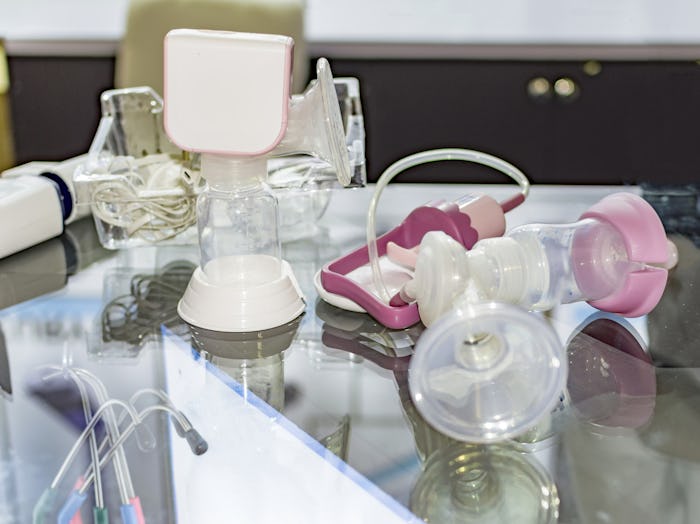Life

9 Mistakes You're Making With Your Breast Pump
Much like learning to breastfeed, using a breast pump is something that takes patience and time to fall into a setting or routine that works best. Although many lactation consultants suggest sticking to a routine to get milk flowing consistently, each mom finds that different things work best for them when it comes to pumping. If you're struggling to get the milk flowing or find yourself dreading pump time, you may be falling prey to one of the ways you're using your breast pump incorrectly. But don't panic yet. Just like anything, pumping will soon become easier and eventually secondhand.
Some of the most common problems moms come across when beginning to pump is difficulty with let-down, feeling uncomfortable, wondering if they're using the equipment efficiently, and worrying about how much milk they should be producing in a single pump session. With each pump session, however, you'll find most of these concerns and questions begin to clear up as you get into an efficient and comfortable groove.
That being said, there are still a lot of pumping aspects that even the experienced pumping mom may not realize they're doing incorrectly. If you're wondering some of the breast pump don'ts to avoid, or just need some advice to get milk production flowing better, check out these nine tips below.
1You Use The Wrong Size Breast Shield
According to Best Cloth Diapers, if your nipples are white or feel rubbed raw, you may be using a small breast flange, which range in size from 21 mm to 36 mm. To make sure you're using the correct size, your nipple should move freely with suction. The skin surrounding your nipple, however, should not be getting sucked in unless your flange is too big.
2You're Not Using Support
When you're pumping, it's important to make sure you're supporting your breasts and the breast shields. A brasier is a great way to support yourself while pumping and remain hands-free, or if you'd rather, Medela suggested holding your breast shield between your thumb and index finger while using the rest of your hand to support your breast.
3You Pump At A Setting That's Too High
If you're pumping at a setting that feels uncomfortable or painful, you may want to try turning the suction down. Medela shared that pumping at maximum comfort vacuum is the best speed to stay at. Turning up the pump too high can cause soreness and even numbness for your nipples.
4You Start Your Pump Suction Too Low
Although you don't want to pump at a setting that's so high it's causing pain or nipple problems, it's still a good idea to start off pumping at a slightly higher setting and lower after you let-down, according to My Natural Baby Birth. The idea behind this is that the higher speed in the beginning is similar to what your baby does when she breastfeeds before your milk releases and she slows down.
5You Don't Switch Sides Frequently
According to The Pump Station and Nurtury, pumping both sides at the same time raises prolactin — a milk-producing hormone — and increases supply. However, if you're only able to pump one side at a time, you should switch sides each time the milk stops flowing well in one breast. La Leche League International (LLLI) noted that pumping each breast in shorter sessions is more efficient than longer ones.
6You Stare At The Pump
Much like watching the time go by as you await the end of a meeting or event, staring at the pump can cause somewhat of a psychological barrier or frustration that makes it seem to take longer than it should or hinders flow. Certified lactation consultant Corky Harvey suggested doing something to distract yourself while you pump like listening to music, watching television, or calling a friend.
7You Don't Clean Equipment After Each Use
According to the FDA, breast pump parts, such as shields, storage containers, and valves, should be cleaned after each use. In order to keep pump parts clean, rinse off each piece in cool water after use, then apply dishwashing soap and warm water. Lastly, run each piece under hot water for 10 to 15 seconds. Some moms, depending on the pump, are able to boil their pump parts in hot water or throw them in the top rack of the dishwasher.